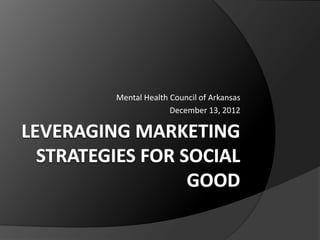
Leveraging Marketing Strategies for Social Good
- 1. Mental Health Council of Arkansas December 13, 2012
- 2. Independent Consultant in Nonprofit Marketing, Fundraising, and Strategic Planning
- 3. Language shapes the way we think, and determines what we can think about. Benjamin Lee Whorf If we use words, there is a very grave danger they will be misinterpreted. H. R. Halderman
- 5. Hurricane Sandy Syria
- 6. What is marketing? The American Marketing Association Board of Directors approved this definition in 2007: “Marketing is the activity, set of institutions, and processes for creating, communicating, delivering, and exchanging offerings that have value for customers, clients, partners, and society at large.” ○ www.MarketingPower.com
- 7. Why engage in marketing strategies? Effective “messaging” strategies are highly researched and tested Audiences are sophisticated and savvy Legislative sessions are “noisy”
- 9. Analyze the Audience Who are the stakeholders? Mental health care program administrators Mental health care patients or clients, current and future Citizens of the state Hospitals State government Justice system Law enforcement Families
- 10. Analyze the Audience Who are the decision makers? Legislators ○ Analyze the legislative audience: Who are they? What is their education level? What is the political environment for this issue?
- 11. Analyze the Challenges What are the challenges? Lack of education on issues Prejudices and misconceptions about people with mental health disabilities Current economic situation Current attitudes about government in general High turnover in the legislature because of term limits Competing issues
- 12. Determine the Purpose Develop certainty and consensus within the group about the final goal Immediate goal Long-term goal If more than one outcome is desired, prioritize the goals (so that you are prepared for a Plan B) State the immediate goal clearly and simply – one sentence if possible List the long-term outcomes if goal is achieved
- 13. Develop a Case – Hard Facts Use numbers and statistics – no jargon! Keep them simple and targeted Make sure they are easily repeatable Create a paragraph or two about the history of the problem and previously tried solutions
- 14. Develop a Case – Emotional Appeal What kind of specific story can you tell, while preserving confidentiality? Do you have a trusted spokesperson who can tell his or her own story? Find these stories regionally Prepare the spokespersons in advance Storytelling is the most powerful strategy.
- 15. Develop a Case – Practical Appeal What is the economic impact? What is the community impact? How does it affect the average person? What are the consequences for not acting? What are the benefits of acting now?
- 16. Anticipate the Opposition Outline the known or potential objections Practice responding to the opposition Incorporate responses to the opposition into message
- 17. Creating “Talking Points” 30-second elevator speech 5-minute speech Identified and clearly outlined key words and phrases Develop a one-page white paper Unified message ALWAYS
- 18. The One-Page Case Statement One or two sentences that state the immediate goal Short paragraph of history of the issue Talking points (in bullet form) from the case that’s been developed Hard facts Emotional appeal Practical appeal Response to opposition Description of long-term outcomes of proposed legislation
- 19. Call to Action What do you want stakeholders to do? What do you want legislators to do? Be prepared to say it over and over and over and over and over . . .
- 20. General Advice Talk only about what you DO, not what you don’t do - use affirmative language Use plain language, not technical or medical language Be prepared to say the same thing over and over 9,000 times and stick to the script Know what your funding allows you to do
- 22. Analyze the Opportunities New health care legislation Key committee members and committees Identify advocates for the issue, the stakeholders, and the legislation
- 23. Analyze the Obstacles Competing issues Advocate conflicts Public perceptions
- 24. Identifying the Market Where do you find the legislators and the key markets? Which media channels work best for this message? Television Newspaper Social Media Press conferences? Professional publications, like an agency’s or organization’s newsletter
- 25. Events Create events or opportunities for news coverage Press releases for those events should outline the key points
- 26. Some Legislative Realities Hundreds of pieces of legislation flying by Legislators with no staff to help them sift through bills Emails from constituents make a difference! Lots of junk legislation
Editor's Notes
- Example of the mayor’s use of the boot on the tire picture.The alcohol tax that would give money to shelters, rehab programs, etc. when I called my state senator, she had no idea what I was talking about.
